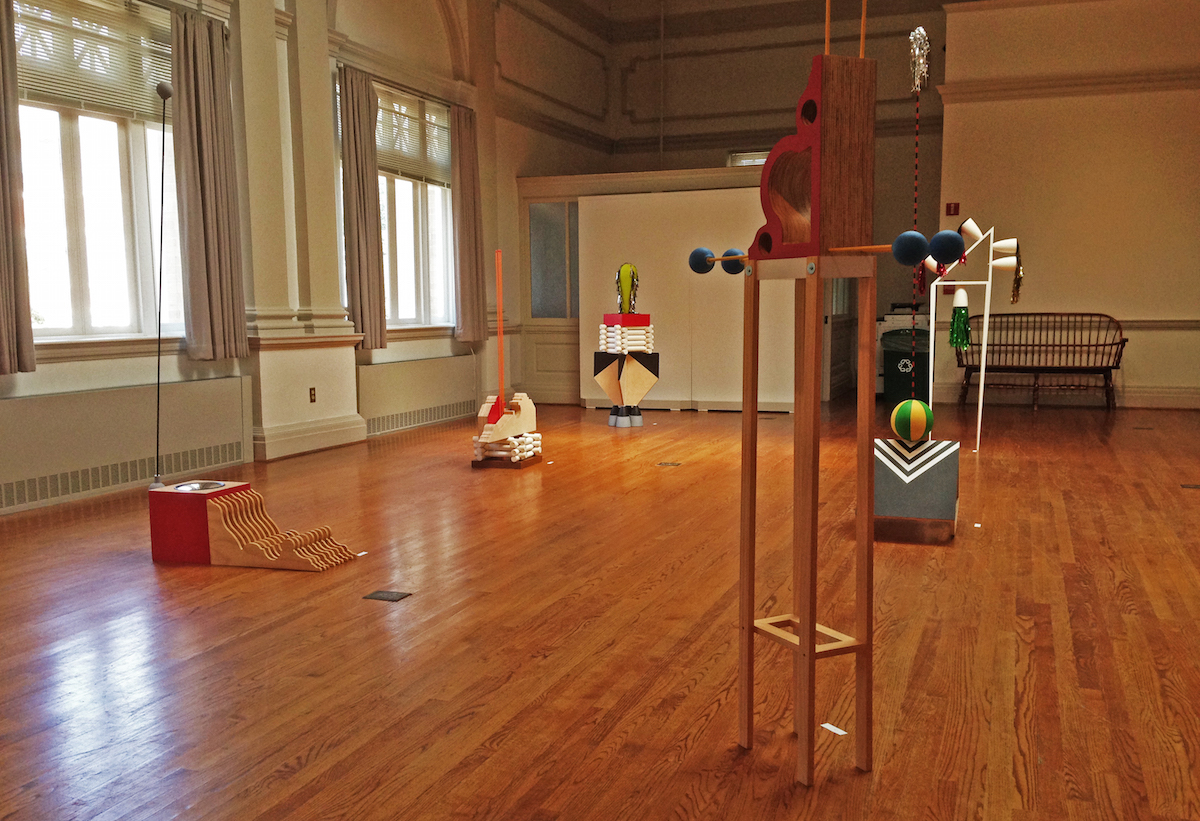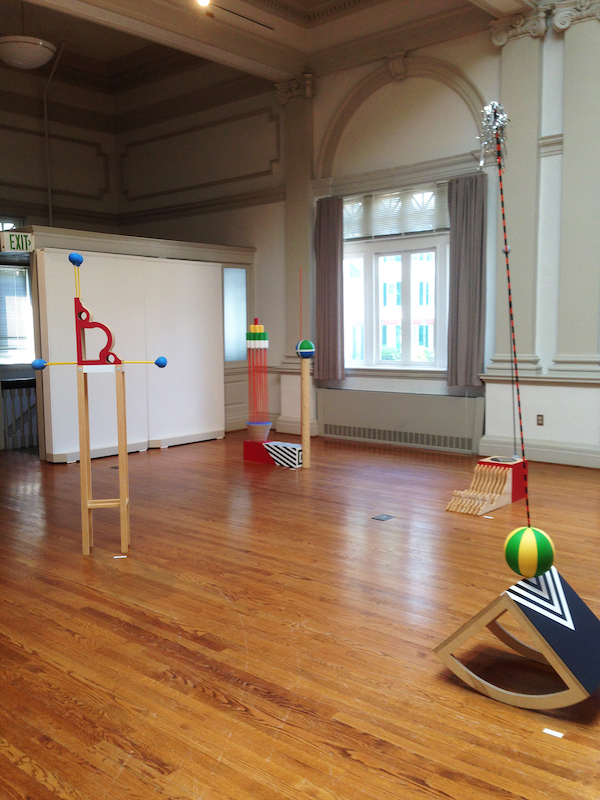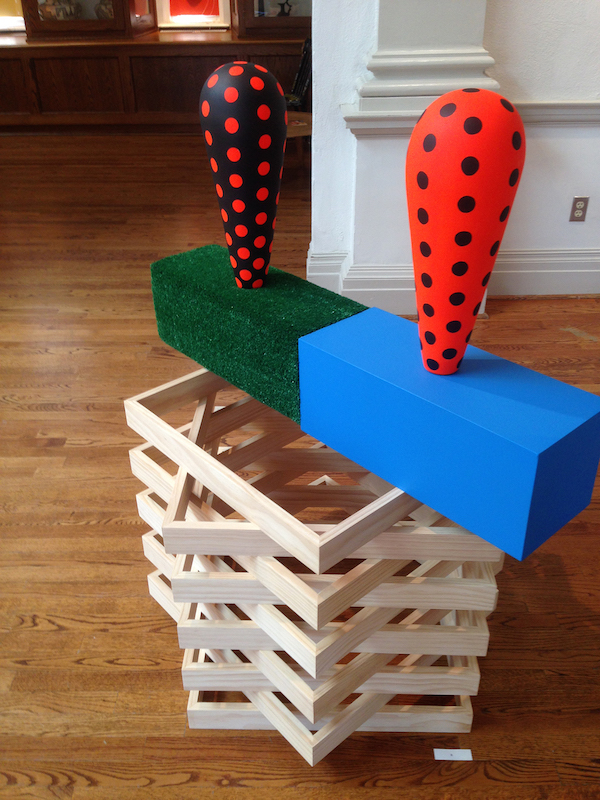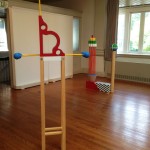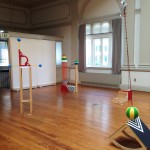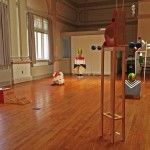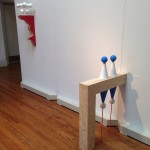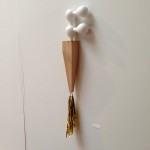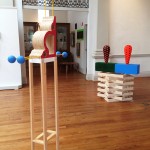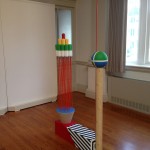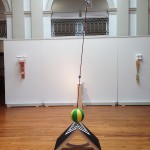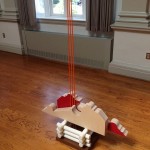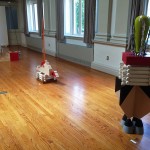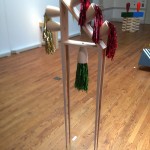Kyle’s Bauer’s Solo Exhibition at McDaniel College’s Rice Gallery Pairs Contradictory Materials and Ideas, the Pythagorean Theorem, and Nautical Navigation
By Nicole Ringel
Imagine a future in which GPS is made of porcelain and placed on a stack of meticulously balanced wooden frames. Although the sculptures of Kyle Bauer are constructed by clean, formalist shapes and materials, their unorthodox arrangement and variety of references in solo exhibit Don’t Fly Too Close to the Sun at McDaniel College’s Rice Gallery create an intricate, discordant balance that challenges the viewer’s orientation in space and time.
Bauer’s “Pythagoras Light Tree” consists of a wooden right triangle elevated by four long, tapering legs. Jutting out from each side of the triangle are shiny plastic streamers in porcelain cones. The bright sparking colors of the streamers contrast the natural material of the exposed wooden legs and the matte texture of the porcelain. Together, the materials present a collage of contrasting influences; while the streamers are something like what you would expect to find in Party City, the shape of the porcelain cones is strikingly similar to a showerhead. The use of porcelain calls to mind precious, fragile dinnerware, while the wooden frame to which they are bolted presents the strength and integrity of real construction. This conglomeration of seemingly contrasting materials creates tension, yet the piece accomplishes an intricate balance that is minimal, clean, and elegant.
In addition to the materials themselves embodying a cacophonous variety of influences, the piece reaches back in history with its reference to Pythagoras, the ancient Greek mathematician famous for developing the formula for finding the area of a right triangle. Through connecting the construction to a concrete geometric law, Bauer creates a sense that the piece has a sense of correctness and formalism despite its unconventional construction and playful style. The logical purity of Pythagoras’s theorem brings an absurd feeling that the streamers, ceramic cones, and wooden base are equally as profound and enduring, despite their strange juxtaposition.
Bauer challenges the notion of space and time in his work by incorporating references to traditional methods of maritime navigation. “Composition 411” consists of a long, orange and black-checkered pole tilted upon a rocking cone shape. The base is exposed wood on the sides, but is painted black with repeating white triangle outlines on the top. Two porcelain balls are resting on the pole, and a silvery mess of streamers decorates the top. The rocking shape of the base could be a reference to a sextant, a tool used by sailors to measure the relative location of a ship to the stars, or a swinging pendulum, similar to the ones used in the earliest maritime clocks. The tilted pole is also reminiscent of a compass needle, which even more directly manifests the notion of direction and orientation. Despite embodying methods of navigation, the fragile balance of tilted and tense materials and shapes create conflict and confusion in the space, and ultimately are more disorienting than helpful.
This paradox is an integral part of the exhibition. Even the show’s title, Don’t Fly Too Close to the Sun, references the plight of the ancient inventor Daedalus and his son Icarus, and their tragic escape from the winding labyrinth of Crete. The grid-like arrangement of the sculptures across the floor resembles the grid of a labyrinth in some ways and the diagonal poles, floating balls, off-kilter shapes, and contrasting angles create a similarly confusing experience, referencing both the constriction of the grid and a botched escape attempt which could have succeeded had clear directions been followed. Although the grid of structures is logically coherent, it forces viewers to question how to orient themselves within the space. The haunting story of Icarus’s death brings additional tension to the scene; just as his flight from the maze required an intricate balance of distance from the sun and the sea, each sculpture offers an exact proportion of tension and control.
Though Bauer’s influences reach as far back as the ancient Greeks, his formalist method of construction brings a new, sleek, and clean appearance to tools from the 15th century and tales from antiquity. Bauer has recreated the labyrinth of Crete using minimal geometric structures to achieve a clean, articulate aesthetic similar to the minimalism of contemporary design. Elements of sailors’ first navigational techniques are disguised and transformed into structures made from new materials such as astroturf and streamers; porcelain beach balls are scattered among other perfectly shaped forms. The culmination of all of these competing forms and references challenges the viewer’s notion of time; their simultaneity is both a creation of something new, and a testament to the legacy of Greek mythology and maritime exploration.
These works effectively combines a multitude of references to create sleek, formalistic sculptures that embody tension, discordance, and direction within the space of Rice Gallery. Through balancing opposing ideas, the sculptures in don’t fly too close to the sun stand in the middle of simultaneous principles: orientation vs. disorientation, balance vs. chaos; and past vs. present. The strange, jutting angles and rounded ceramic forms of Bauer’s sculptures achieve a fragile balance that challenges notions of time and space.
Kyle Bauer: don’t fly too close to the sun will be on exhibit through September 25 at McDaniel College’s Rice Gallery.
Author Nicole Ringel was raised in Frederick, Maryland and is currently pursuing a BFA in Studio Art and Art History at McDaniel College in Westminster, Maryland. She is an artist and reader, and is especially interested in community and socially engaged art.


